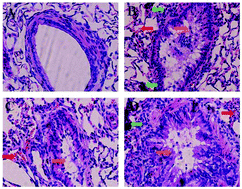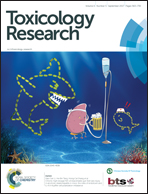Effects of ambient PM2.5 and 9-nitroanthracene on DNA damage and repair, oxidative stress and metabolic enzymes in the lungs of rats
Abstract
Ambient fine particulate matter (PM2.5) is a complex mixture associated with lung cancer risk. PM2.5-bound nitro-polycyclic aromatic hydrocarbons (NPAHs) have been demonstrated to possess mutagenicity and carcinogenicity. Previous studies showed that PM2.5 induced DNA damage, whereas there is little knowledge of whether 9-nitroanthracene (9-NA), a typical compound of NPAHs in PM2.5, causes DNA damage. Also, the regulating mechanisms of PM2.5 and 9-NA in DNA damage and repair are not yet fully established. Here we sought to investigate the molecular mechanisms of DNA damage and repair in the lungs of male Wistar rats exposed to PM2.5 (1.5 mg per kg body weight) or three different dosages of 9-NA. And then DNA strand breaks, 8-OH-dG formation, DNA–protein crosslink and DNA repair gene expressions in rat lungs were analyzed. In addition, alteration in oxidative stress factors and metabolic enzymes were detected. The results showed that (1) PM2.5 and higher dosage 9-NA (4.0 × 10−5 and 1.2 × 10−4 mg per kg body weight) significantly caused lung DNA damage, accompanied by increasing OGG1 expression while inhibiting MTH1 and XRCC1 expression, elevating the levels of GADD153, hemeoxygenase-1 and malondialdehyde, and promoting the activities of CYP450 isozymes and glutathione S-transferase. (2) 1.3 × 10−5 mg kg−1 9-NA exposure couldn't cause DNA damage and oxidative stress. (3) At the approximately equivalent dose level, PM2.5-induced DNA damage effects were more obvious than 9-NA with positive correlation. It suggests that DNA damage caused by PM2.5 and 9-NA may be mediated partially through influencing the DNA repair capacity and enhancing oxidative stress and biotransformation, and this negative effect of 9-NA might be related to the PM2.5-induced lung genotoxicity.



 Please wait while we load your content...
Please wait while we load your content...